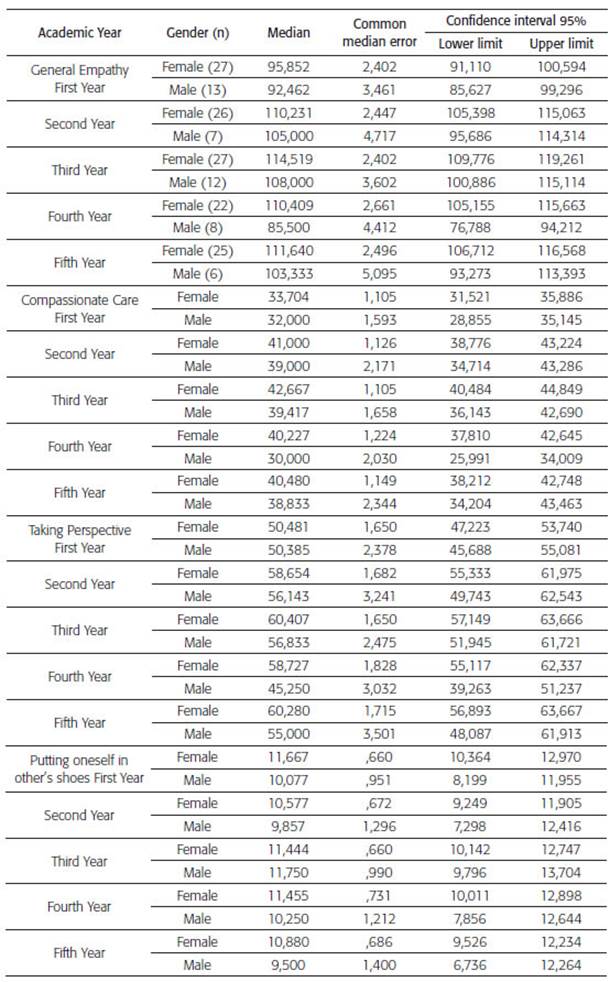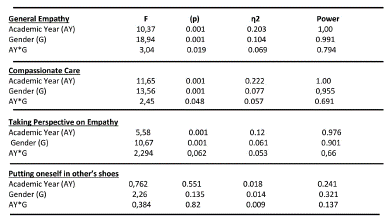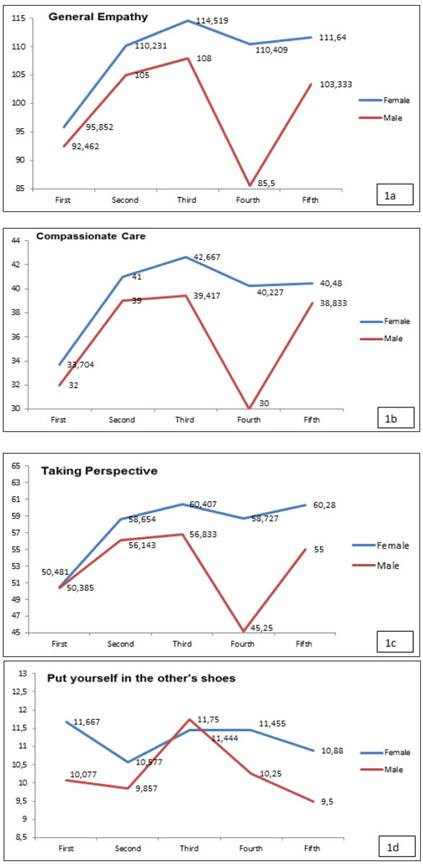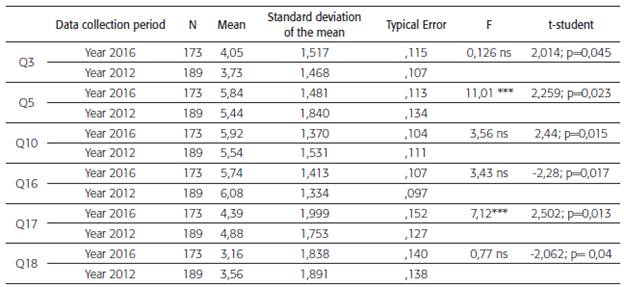INTRODUCTION
The relationship between the health care provider and the patient entails a subjective and intersubjective relationship that goes beyond the clinical aspect of any treatment 1,2. In order to attain humanization in health care, every health care provider must be able to develop an empathic communication with his /her patients 3,4.
Empathy in health care can be understood as a cognitive and behavioral attribute that implies the ability to understand how the patient's experiences and feelings are influenced by his/her disease and symptoms as well as the ability to transmit that understanding to the patient 5,6. This is related to several attributes; among them we can mention better therapeutic relationships and good clinical results 1,7,8.
It has been proposed that empathy is modifiable and that it can be developed intentionally 9,13. De la Rosa et al. 14 state that the training in interpersonal skills must be permanent during the process of professional development. It is believed that universities are responsible in developing this attribute.
In this regard, the orientation of health education curricula to the development of empathy is very relevant 15. As regards gender implication in the dentist-patient relationship, women have been considered in general more competent than men; they are considered to be more caring and expressive apart from humanitarian and compassionate 11.
We aim to assess UCC Dentistry first to fifth year students' empathy levels, considering gender and academic year and to compare these results to the ones obtained in a similar group of students five years ago 16. Our objective is to prove if there have been any changes in empathy levels after a sustained information (throughout the career) on the importance of this attribute.
MATERIALS AND METHODS
Exploratory, cross-sectional study. Population: UCC Dentistry students from 1st to 5th year of the career (2016 N=218; 2012: N=223). 2016 sample: 173 (79,36%); 2012 sample: 189 (84,75%). The study was stratified taking into account two variables: academic year (AA) and gender. A Spanish version for health science students of Jefferson's Empathy Medical Scale was applied; the version was validated in Mexico and Chile, and culturally adapted to Argentina according to the criterion of judges in order to verify cultural and content validity 20. A pilot test was applied. The study was performed according to Helsinki Norms and approved by the UCC Committee on Ethics. The students signed an informed consent 18. Data underwent tests for Normality and Equality of variance. Internal reliability was estimated by Cronbach's alpha general and elements were eliminated by intraclass correlation coefficient, Hotellin T2 test and Tukey's test. Medians, standard deviation, standard error of the median and confidence interval (IC) were estimated.
A Cronbach's Alpha coefficient of 0.72 was obtained. This confirmed the remarkable internal consistency and stability of the scale.
An analysis of bifactorial variance (ANOVA) model III was applied in order to find the differences of the medians among academic years, gender and these factors interactions. Data were described by means of simple arithmetic charts and processed with SPSS 22.0. Possible growth total potential (PTCP, its initials in Spanish) was considered as the quotient between two magnitudes: a) the real difference between the scores observed in 5th year students minus the scores of first year students (D1) with respect to b) the possible difference between the greater empathy measurement this instrument allows (140) as to the real empathy score of first year students (D2): PTCP = D1/D2. PTCP is an indicator of the degree of progress in empathy levels and they can be observed in both longitudinal and cross-sectional studies. The level was α < 0,05 and β < 0,20 in every case. The comparison of empathy data in students of this career (2012) obtained in a previous study 16 with those observed in the present study was made by means of a t-student test. The significance level used was α < 0,05 and β < 0,20 in every case.
RESULTS
Kolmogorov-Smirnov and Levene tests were not significant (p>0,05); data were distributed in a normal way and there was homoscedas-ticity. Cronbach's alpha was satisfactory (non typified=0,766 and typified=0,789), they were assumed to have internal consistent reliability. Cronbach's alpha total value, if an element was eliminated, fluctuated [0,771;0,804], reliability was proved independently of one of the elements elimination.
The Intraclass Correlation Coefficient (ICC) was 0,792 (F=4,82; p=0,001), confirming adequate reliability. T2 Hotelling test (F=29,99;p=0,001) and Tukey's Test for non-Additivity (F=29,41;p=0,001) allow, in the first case, to infer that the medians of the questions are different among them, and that not all of them count equally for the average median 5,29: variability among answers to the instrument and, in the second case, to infer an additive character of the data (a larger sample is required).
Results show that adequate methods were used for the analysis. Results of the medians estimates (total and combined by factor), the typical error of the median and the sample size are shown in Table 1.
Table 1 Result of the estimation of descriptive statistics of empathy levels in each factor and in each component studied

Table 2 shows the results of empathy values in general and their components. In "General Empathy", both the differences in values observed in each academic year and in both genders were highly significant (p<0,005) as well as the interaction (p<0,05). The value of the median among women was 108,56 (common median error (ETM, its initials in Spanish, = 1,11) and among men 98,859 (ETM, its initials in Spanish, =1,93). The factors studied help us explain the 28,95% empathy variation in general (R2=0,289). The estimation of the potential growth of first year students was 13,33 points, i.e., only 29,08% of the total possible growth.
Table 2 Results of the application of the ANOVA, the value of F, eta-squared and power of the test used

P = probability of committing type I error
* Interaction symbol between factors AY and G
In the "Compassionate Care" component, equal results to "General Empathy" were found. Both factors were found to be highly significant (p<0,005); interaction was significant (p<0,05). The median value in both genders was: 39,62 among women (ETM=0,511); and 35,85 among men (ETM=0,886). These two factors account for the variance component of 28,5% (R2=0,285). First year students' potential growth estimate was 18,99% of the total possible empathy growth.
In the "Taking Perspective" component, the differences found among different academic years and genders were highly significant (p<0,005) in both factors; however, interaction was not significant (p>0,05). The median value in both genders was: 57,71 among women (ETM=0,763) and57,72among men (ETM=1,32). Both factors account for 18,2% of the empathy variance component (R2=0,182). The potential growth estimate was 7,21 points, i.e., 36,84% of the total possible empathy growth.
Finally, none of the registered differences among the studied factors were significant (p>0,05) in "Putting Yourself in Others' Shoes" component. The gender median value was: 11,21 among women (ETM=0,305) and 10,29 among men (ETM=1,53). The studied factors only account for 1,7% of this component variance (R2=0,017). The potential growth estimate was -0,68 points, i.e., there was a -6,71 decrease of the total possible growth.
In Figure 1 (Ia-1d) the median behaviors of academic year and gender factor levels are shown. Females were found to behave different from males as to "General Empathy" and in every component with the exception of "Putting Yourself in Other's hoes". In every case, both males and females tended to decrease their general empathy attitude and their components from third year onwards; yet, there was a mild tendency to increase it again (especially in fifth year) with the exception of the last component.

Figure 1 Distribution of the means of Empathy in General and of each of its components according to the academic year and gender.
In figure 3 the results of the comparison between the medians of the answers to "General Empathy" significant questions are shown. The answers were P3 and P18 related to "Putting Yourself in Other's Shoes" and P5, P10, P16 and P17 related to the "Taking Perspective component". No question related to the "Compassionate care" component was significant (p>0,05). The positive values of t-student test show that there was an increase in empathy associated to the corresponding component in the aspect referred to the specific question while the negative values show there was a relapse with respect to the first measurement in the same aspects.
DISCUSSION
During the genesis, development and outcome of any disease, it is of the utmost importance to develop and foster students' interpersonal abilities to face the clinical situations related to the integral assistance of patients. 11,12. Accordingly, it is essential to make a clear diagnosis of the medical students' empathic attitude and /or to assess any possible strategy aimed at increasing this attitude. The first step, in both cases, is to make a proper assessment of the data consistency and reliability in the context of a validated instrument.
The present study found a difference between males and females as to their general empathy and its components, being this difference in favor of female students, with the only exception of "Putting Yourself in Other's Shoes" in which case there was no real statistical difference. Similar results as to gender difference were described by other authors in different Latin American universities and countries 11,19-31.
These differences between genders are not always in favor of females. Some papers have described the three possibilities: a) greater in females than in males (with statistical differences); b) no statistical differences between males and females and c) males have shown more empathy than females, with statistical differences among them. Different authors in Latin America have tried to explain these results 15-25; however, this is still controversial and its elucidation is not our aim.
General Empathy and its components in both genders showed an increasing trend towards third year; they slightly decreased in fourth year and, finally, there was a general tendency to increase in fifth year, with the exception of the last component "Putting Yourself in Other's Shoes". Similar results were obtained by Rojas et al 26, Rivera et al 27 and Díaz-Narváez et al 28 in Physiotherapy and Dentistry students in Chile. They observe a constantly ascending tendency in empathy scores obtained by students from different career levels.
Erazo et al 29 and Howardet et al studies 15 described that empathy increased in fourth and fifth year without any significant difference as to gender, while Bilbao et al 30 did not find any difference between gender or academic year in spite of the absolutely superior scores measured in fourth year. The present study inquired into general empathy and its components between fifth and first year students. EIPTCP got the highest score (36,84%) in the "Taking Perspective" component (general empathy levels and the other components were lower but positive, with the exception of "Putting Yourself in Other's' Shoes" component. Possible consequences of PTCE positive results could be attributed to the fact that the presence of the strategy used in the disclosure of empathy had the expected results; nevertheless, this was not enough to raise empathic attitude to higher levels; and, in the case of the "Putting Yourself in Other's Shoes" component, there was a decrease. After this, empathy increased as regards "Compassionate Care" and "Taking Perspective". The first component has an emotional base and the second one has a cognitive base, as much as "Putting Yourself in Other's Shoes". Therefore, it seems that the right strategy must be aimed mainly at the development of cognitive components, since these can be taught 15,25. Then, this strategy must be associated to a better planned intervention including a new conception of the curriculum that encompasses contact among the students and the patients from the very beginning of the career, a change in the teaching learning process which has to be active, student-centered and with the teacher showing how to treat the patient, among many other factors. 17,19,20,
Several papers show that there are differences in the results found among different universities. Cultural, social, educational and economic differences are mentioned, amongst others. This fact could encourage the influence of socio-cultural factors in the acquisition of this attitude. Sherman et al 13 and Hojatet et al 5,6 aim at stressing the natural characteristics of the assessed groups, the students' maturity and cultural background, their previous experience and personal development, their participation in group and social activities recognizing the importance of social and psychological factors. These differences have been found in Latin America 25. As a consequence, we must rely on a well done diagnosis of empathy before initiating any intervention in our region.
CONCLUSIONS
The present study findings show that: a) disclosure of empathy in a sustained way along the five years of the career had positive results in increasing empathy levels; b) this strategy; however, did not help to specifically develop cognitive components; c) a new strategy including the teaching of cognitive elements and stimulating the emotional ones in an integral way is necessary; d) it is necessary to make deeper studies to prove if males should receive a different training than females and e) it is necessary to include qualitative studies addressing patients and students in the clinical setting. This last point could contribute to observe the variable evolution along time, to get to know the elements that promote it and to relate them to the formative strategies that enhance the students' empathic attitude. On the other hand, this paper has a sample size limitation. The sample is finite and can not be arbitrarily increased; however, the statistical tests used in the comparisons consider the sample size in the different levels of the studied factors.















